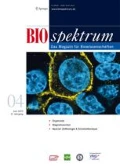Abstract
Plant-pathogenic xanthomonads have evolved TAL effectors (TALEs) as activators of plant genes to manipulate the host to their benefit. Cracking the code of TALE DNA-binding specificity revealed a simple one-to-one relationship between protein domains and DNA bases bound. This now allows the simple design of any desired DNA-binding specificity. Accordingly, TALEs and their nuclease derivatives have soared as biotechnology tools for gene control and genome engineering.
Similar content being viewed by others
Literatur
Boch J, Bonas U (2010) Xanthomonas AvrBs3 family-type III effectors: discovery and function. Annu Rev Phytopathol 48:419–436
Boch J, Scholze H, Schornack S et al. (2009) Breaking the code of DNA binding specificity of TAL-type III effectors. Science 326:1509–1512
Deng D, Yan C, Pan X et al. (2012) Structural basis for sequence-specific recognition of DNA by TAL effectors. Science 335:720–723
Mak ANS, Bradley P, Cernadas RA et al. (2012) The crystal structure of TAL effector PthXo1 bound to its DNA target. Science 335:716–719
Streubel J, Blücher C, Landgraf A et al. (2012) TAL effector RVD specificities and efficiencies. Nat Biotechnol 30:593–595
Geißler R, Scholze H, Hahn S et al. (2011) Transcriptional activators of human genes with programmable DNA-specificity. PLoS ONE 6:19509
Miller JC, Tan S, Qiao G et al. (2011) A TALE nuclease architecture for efficient genome editing. Nat Biotechnol 29:143–148
Garg A, Lohmueller JJ, Silver PA et al. (2012) Engineering synthetic TAL effectors with orthogonal target sites. Nucl Acids Res 40:7584–7595
Bultmann S, Morbitzer R, Schmidt CS et al. (2012) Targeted transcriptional activation of silent oct4 pluripotency gene by combining designer TALEs and inhibition of epigenetic modifiers. Nucl Acids Res 40:5368–5377
Kim Y, Kweon J, Kim A et al. (2013) A library of TAL effector nucleases spanning the human genome. Nat Biotechnol 31:251–258
Osborn MJ, Starker CG, McElroy AN et al. (2013) TALENbased gene correction for epidermolysis bullosa. Mol Ther, doi: 10.1038/mt.2013.56
Grau J, Wolf A, Reschke M et al. (2013). Computational predictions provide insights into the biology of TAL effector target sites. PLoS Comput Biol 9:e1002962
Author information
Authors and Affiliations
Corresponding author
Additional information
Annekatrin Richter, Maik Reschke und Jana Streubel (v. l. n. r.) Biologiestudium an der Martin-Luther-Universität Halle. Zurzeit Promotion in der Arbeitsgruppe von Jens Boch (ganz rechts).
Jens Boch 1987–1993 Biologiestudium an der Universität Marburg; dort 1996 Promotion am Lehrstuhl für Mikrobiologie. 1996–1997 Postdoc am Max-Planck-Institut für Terrestrische Mikrobiologie, Marburg. 1997–1999 Postdoc an der Washington University in St. Louis, MO, USA. Seit 1999 Leiter einer Nachwuchsgruppe in Halle. 2013 VAAM-Forschungspreis 2013.
Rights and permissions
About this article
Cite this article
Streubel, J., Richter, A., Reschke, M. et al. TALEs — Proteine mit programmier — barer DNA-Bindespezifität. Biospektrum 19, 370–372 (2013). https://doi.org/10.1007/s12268-013-0322-0
Published:
Issue Date:
DOI: https://doi.org/10.1007/s12268-013-0322-0




